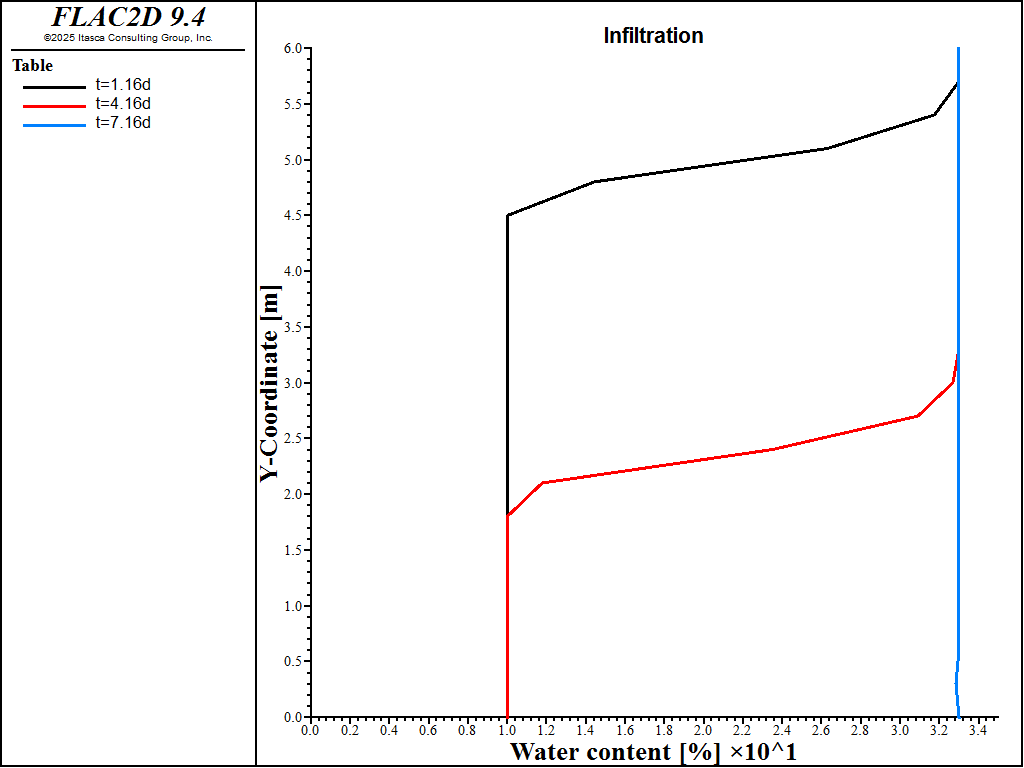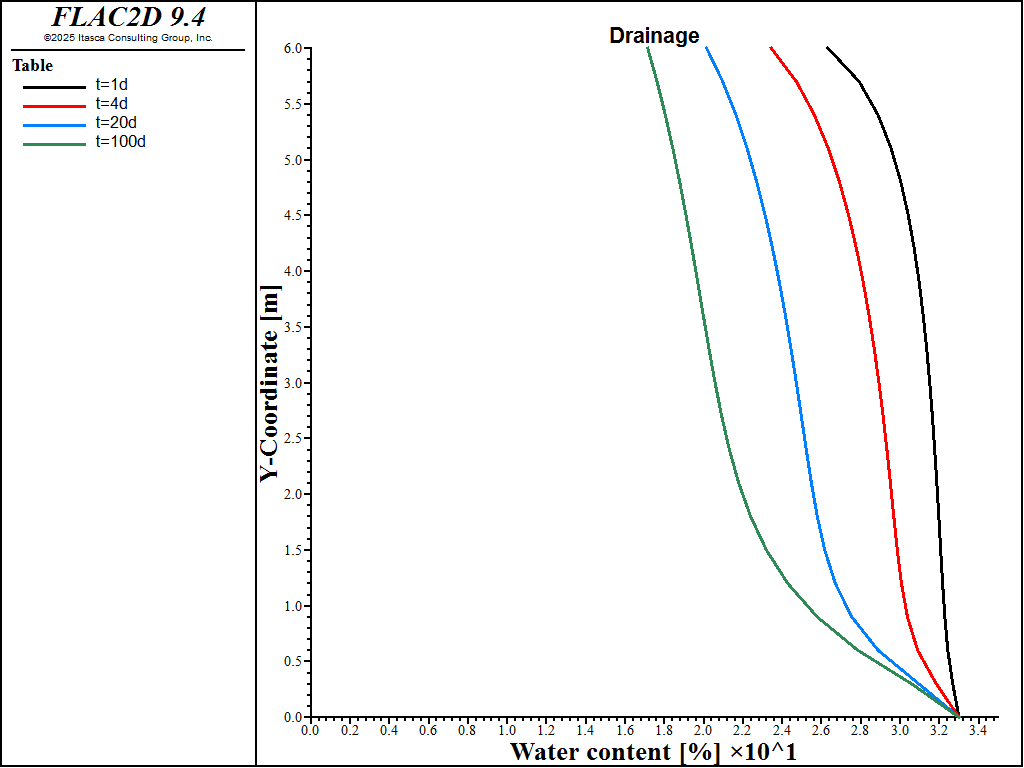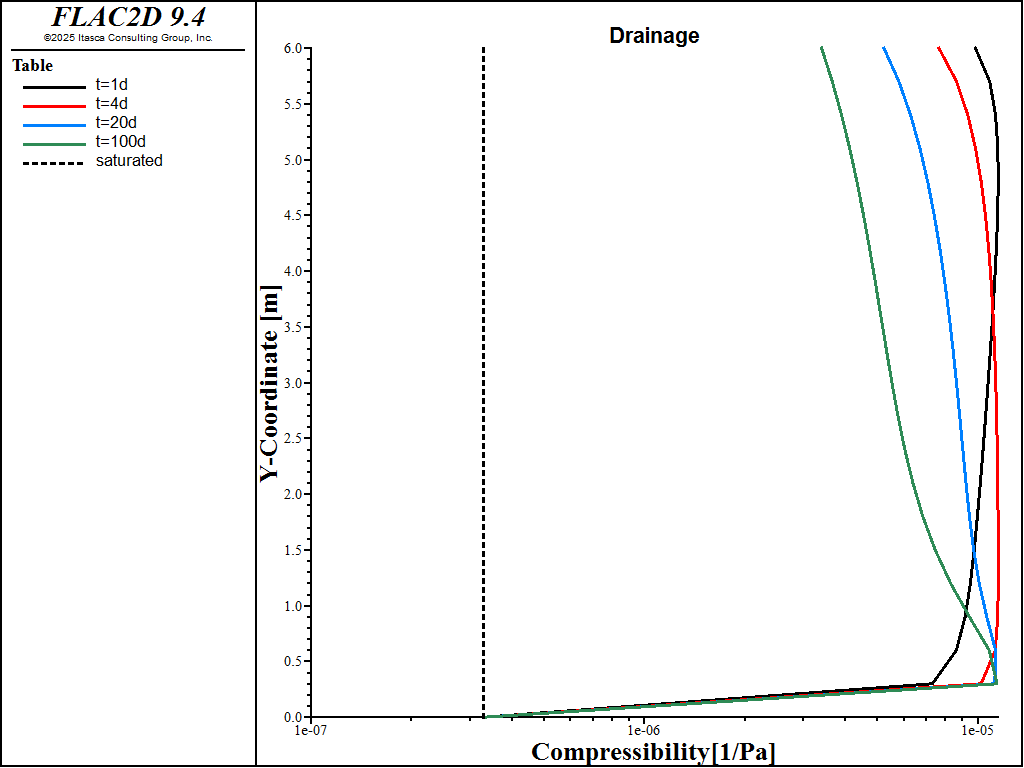Saturation and Drainage of a Caisson (FLAC2D)
Problem Statement
Note
This project reproduces Example 2.5.1 from FLAC 8.1. The project file for this example is available to be viewed/run in FLAC2D.[1]. The project’s main data files are shown at the end of this example.
This one-dimensional example involves simulation of infiltration in a large caisson, and drainage by gravity following complete saturation. The geometry, properties, initial, and boundary conditions correspond to those of the Test Problem 1 in Forsyth and Wu (1995). The caisson is 6 m in height and 0.3 m in width. The water saturation is initially \(S_w\) = 0.303 throughout the caisson. Infiltration takes place at the rate of 0.2 m/day at the top of the caisson until it is fully saturated. Subsequently, drainage by gravity is allowed to take place at the bottom of the caisson for a period of 100 days. The material properties used in the model are those of the Bandelier Tuff (see Table 1 in Forsyth and Wu (1995)). These are listed in Table 1.
Property |
Value |
|---|---|
Porosity |
0.33 |
Sat. mobility coefficient |
2.92 \(\times\) 10-10 m2/Pa s |
Intrinsic permeability |
2.95 \(\times\) 10-13 m2 |
Wetting-phase viscosity |
1.01 cP |
Wetting-phase compressibility |
0.001 kPa-1 |
Rock compressibility |
0.0 kPa-1 (rigid) |
Residual saturation |
0.0 |
van Genuchten \(m\) |
0.336 |
van Genuchten \(n\) |
1.506 |
van Genuchten \(p_{ref}\) |
7 kPa |
Rel. permeability exponent \(b\) |
0.5 |
A column of 20 zones is used to represent the caisson. During the infiltration phase, the bottom boundary is closed until fully saturated. After that, the wetting-phase pressure is kept constant at zero along the bottom boundary. Rock compressibility is assumed to be zero, i.e., rigid. Moreover, the relative permeability of the wetting-phase is given by:
where \(k_{rw}\) is the relative permeability of the wetting-phase, \(S_{w}\) is the water saturation, \(b\) is the relative permeability exponent, and \(m\) is a van Genuchten fitting parameter.
Changes in wetting-phase pressure \(p_w\) are governed by the following equation, assuming an isothermal, rigid skeleton:
where \(M\) is the saturated Biot modulus, \(\zeta\) is the variation of fluid content, \(\phi\) is the porosity, and \(p_c=-p_w\) is the capillary pressure, or suction. The term on the left hand side of equation (3) and in brackets is the inverse of the Biot modulus in partially saturated conditions. This value is stored as a FISH extra gridpoint variable during the drainage phase to visualize the impact of saturation on the Biot modulus.
Results
Figure 1 shows the water content profile (porosity times water saturation) over the caisson height at 1.16, 4.16, and 7.16 days. After complete saturation, the infiltration rate is set to zero and gravity drainage is simulated for 100 days. The predicted water content profile at 1, 4, 20, and 100 days is given in Figure 2. Lastly, the impact of saturation on the Biot modulus is shown in Figure 3. The Biot modulus is only equal to the value under fully saturated conditions at the bottom of the caisson (\(y=0\) m) where saturation is 1. Everywhere else in the caisson, partially saturated conditions prevail during drainage and this has a non-negligable impact on the transient response.

Figure 1: Water content profile during infiltration.

Figure 2: Water content profile during drainage.

Figure 3: Compressibility profile during drainage. This is the inverse of the partially saturated Biot modulus.
Reference
Forsyth, P. A. and Y. S. Wu. “Robust numerical methods for saturated-unsaturated flow with dry initial conditions in heterogeneous media,” Advances in Water Resources, 18, 25-38 (1995).
Data Files
saturation_drainage.dat
model large-strain off
model configure fluid-flow
model gravity 0 -10
[Cw = 1e-6] ; Wetting phase compressibility [1/Pa]
[Cnw = 1e-3] ; Non-wetting phase compressibility [1/Pa]
[n = 1.506] ; Van-Genuchten n
[m = 0.336] ; Van-Genuchten m
[pr = 7e3] ; Van-Genuchten pref [Pa]
[b = 0.5] ; Relative permeability exponent
[q = 0.2 / 86400.0] ; Wetting phase injection rate [m/s]
program call "functions"
zone create quadrilateral size 1 20 ...
point 0 (0,0) point 1 (0.3,0) ...
point 2(0,6)
zone fluid property fluid-density 1000 porosity 0.33 ...
mobility-coefficient 2.92e-10 fluid-modulus [1/Cw]
zone fluid unsaturated van-genuchten [n] [m] [pr]
[init_pp]
[rel_perm]
zone fluid property effective-cutoff -1e20
zone fluid permeability-saturation table "krw"
zone face apply discharge [q] range position-y 6
fish callback add water_content -1 interval 10
; Step 1: Solve to fully-saturated
model solve-fluid time-total 1.0e5
[save_profile("wc_1.16d", 1)]
model solve-fluid time-total 3.6e5
[save_profile("wc_4.16d", 1)]
model solve-fluid time-total 6.2e5 fish-halt is_saturated
[save_profile("wc_7.16d", 1)]
; Remove injection, allow drainage
zone face apply-remove discharge range position-y 6
zone face apply pore-pressure 0 range position-y 0
model fluid time-total 0
fish callback add apparent_Cw -1 interval 10
; Solve for 100 days
model solve-fluid time-total [86400 * 1]
[save_profile("wc_1d", 1)]
[save_profile("ac_1d", 2)]
model solve-fluid time-total [86400 * 4]
[save_profile("wc_4d", 1)]
[save_profile("ac_4d", 2)]
model solve-fluid time-total [86400 * 20]
[save_profile("wc_20d", 1)]
[save_profile("ac_20d", 2)]
model solve-fluid time-total [86400 * 100]
[save_profile("wc_100d", 1)]
[save_profile("ac_100d", 2)]
functions.dat
fish define init_pp
; Initialize constant initial pore pressure
local Swi = 0.303
local pi = -pr * (Swi^(-1.0/m)- 1.0)^(1.0 - m)
gp.pp(::gp.list) = pi
gp.sat(::gp.list) = Swi
end
fish define rel_perm
; Wetting phase relative permeability
local tab = table.create("krw")
loop for(local i = 0.01, i <= 1.0, i += 0.01)
krw = i^(b)*(1.0 - (1.0 - i^(1/m))^m)^2
table(tab, i) = krw
endloop
end
fish define is_saturated
; Determine if column is fully saturated
local Sw = list.min(gp.sat(::gp.list))
if Sw > 0.999 then
return true
else
return false
endif
end
fish define water_content
; Compute: porosity * saturation
local phi = zone.fluid.prop(zone.near((0,0)), "porosity")
gp.extra(::gp.list, 1) ::= gp.sat(::gp.list) * phi * 100
end
fish define apparent_Cw
; Compute the inverse of water Biot modulus
local Sw = gp.sat(::gp.list)
local phi = zone.fluid.prop(zone.near((0,0)), "porosity")
local Nw = phi * Sw * Cw
gp.extra(::gp.list, 2) ::= Nw
local pc = -gp.pp(::gp.list)
local ispos = pc > 0.0
local gps = gp.list(ispos)
pc = -gp.pp(::gps)
local dSwdPc = -m*n*(pc/pr)^n*((pc/pr)^n + 1)^(-m - 1)/pc
gp.extra(::gps, 2) -=:: phi * dSwdPc
end
fish define save_profile(tabname, extr)
; Save vertical profile in a table
local gps = gp.list(gp.pos(::gp.list)->x < 1e-6)
local var = gp.extra(::gps, extr)
loop for (local i = 1, i <= list.size(gps), i += 1)
table.x(tabname, i) = var(i)
table.y(tabname, i) = gp.pos(gps(i))->y
endloop
end
| Was this helpful? ... | Itasca Software © 2024, Itasca | Updated: Jun 07, 2025 |
